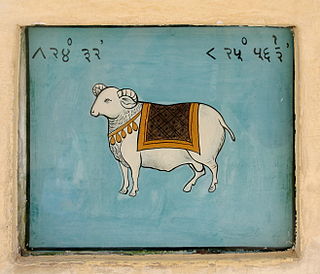Related Research Articles

Varuna is a Hindu god, associated with the sky, oceans, and water. In the Vedic scriptures, he is paired with the god Mitra and is the lord of Ṛta (justice) and Satya (truth). Varuna is also mentioned as an Aditya, the sons of the goddess Aditi.
The Memon are a Muslim community in Gujarat India, and Sindh, Pakistan, the majority of whom follow the Hanafi fiqh of Sunni Islam. They are divided into different groups based on their origins: Kathiawari Memons, Kutchi Memons and Bantva Memons from the Kathiawar, Kutch and Bantva regions of Gujarat respectively, and Sindhi Memons from Sindh.

Khatri is a caste originating from the Malwa and Majha areas of Punjab region of South Asia that is predominantly found in India, but also in Pakistan and Afghanistan. The Khatris claim they are warriors who took to trade. In the Indian subcontinent, they were mostly engaged in mercantile professions such as banking and trade. They were the dominant commercial and financial administration class of late-medieval India. Some in Punjab often belonged to hereditary agriculturalist land-holding lineages, while others were engaged in artisanal occupations such as silk production and weaving.
Bhatia is a group of people and a caste found in Punjab, Sindh and Gujarat. Traditionally, they have been a trading and merchant community. The Bhatias primarily live in Northwestern India and Pakistan. The Bhatias, Lohanas and Khatris were similar communities and were known to intermarry. The Bhatias recruit Saraswat Brahmins as priests.
Lohana are a trading or mercantile jāti mostly in India and also in Pakistan.
Kutchi Memons are an ethnic group or caste from Kutch in Gujarat, India, who speak the Kutchi language. They are related to the Memons associated with the historic state of Kathiawar, a Muslim community of Pakistan and India, who speak the Memoni language. Transliteration of name of this Memon community has now been standardized. Hence popular usage is Cutchi and Kutchi.

Nanakpanthi, also known as Nanakshahi, is a Sikh sect which follows Guru Nanak (1469–1539), the founder of Sikhism.
Hirabad is one of the oldest parts of the city of Hyderabad in Sindh, Pakistan. Before partition in 1947, Hirabad was a thriving township of wealthy Hindu Sindwork merchants and traders who generally belonged to the Amil and Bhaiband castes of Hindu Lohanas.

Chetri Chandra is a festival that marks the beginning of the Lunar Hindu New Year for Sindhi Hindus. The date of the festival is based on the lunar cycle of the lunisolar Hindu calendar, falling on the first day of the year, in the Sindhi month of Chet (Chaitra). It typically falls in late March or early April in the Gregorian calendar on or about the same day as Gudi Padwa in Maharashtra, Ugadi in other parts of the Deccan region and Hindu Samvat Nav Varsha or beginning on New Year in Hindu Samvat Calendar of India.

The description Paris of the East has been applied to a large number of locations, including:
Bhaiband, meaning “brotherhood”, are a Hindu jāti within the Sindhi caste of India and Pakistan.

Jhulelal a folkloric deity among the sect of Sindhis, the most revered deity of Sindhi Hindus in the modern-day republics of Pakistan and India.
Rana Jashraj was elevated to the name Veer Dada Jashraj and he was worshiped as kuladevata by the Lohana caste. In memory of Jashraj, Vasant Panchami is celebrated as a balidaani diwas of Veer Dada Jashraj.
The Amils are a Sindhi Hindu sub-group of Lohana. The word "Amil" has its origin in the Persian word "amal". Amils used to work in Administration in Government services.

Sindhi Hindus are ethnic Sindhis who follow Hinduism and are native to the region of Sindh. They are spread across modern-day Sindh, Pakistan, and India. After the partition of India in 1947, many Sindhi Hindus were among those who fled from Pakistan to the dominion of India, in what was a wholesale exchange of Hindu and Muslim populations in some areas. Some later emigrated from the Indian subcontinent and settled in other parts of the world.
Sindhi workies, also called Sindworkis, Sindworkies, or Sindwork merchants, were wealthy Hindu traders and merchants from the Sindh region of British India. This merchant class rapidly gained prominence during the British rule of India and spread their businesses overseas to places as far as Malta, South Africa and Singapore.

Mesha Sankranti refers to the first day of the solar cycle year, that is the solar New Year in the Hindu luni-solar calendar. The Hindu calendar also has a lunar new year, which is religiously more significant. The solar cycle year is significant in Assamese, Odia, Punjabi, Malayalam, Tamil, and Bengali calendars.
Kishinchand Chellaram was an Indian businessman who operated a global trading network, K. Chellaram & Sons. The firm was founded in 1915, an offshoot of a sindwork trading family in India.
Popati Hiranandani was an Indian writer who authored more than sixty books in Sindhi language during her life. She was an essayist, fiction writer, poet, educationist, feminist and social activist. She made significant contributions to Sindhi literature before and after the partition of India. She won several awards including the Sahitya Akademi Award (1982), Woman of the Year Award (1988), and the Gaurav Puraskar (1990) among others.
References
- ↑ Falzon, Mark-Anthony (2004). Cosmopolitan Connections: The Sindhi Diaspora, 1860-2000. BRILL. ISBN 978-90-04-14008-0.
- ↑ Singh, Kumar Suresh; Bhanu, B. V.; India, Anthropological Survey of (2004). Maharashtra. Popular Prakashan. p. 1862. ISBN 978-81-7991-100-6.
- 1 2 Hīrānandāṇī, Popaṭī (1984). History of Sindhi Literature: Post-independence, 1947-1978. Prof. Popati R. Hiranandani.
- ↑ Falzon, Mark-Anthony (2004). Cosmopolitan Connections: The Sindhi Diaspora, 1860-2000. BRILL. p. 34. ISBN 9004140085.
- ↑ Raina Thapan, Anita (2002). Sindhi Diaspora in Manila, Hong Kong, and Jakarta. Ateneo de Manila University Press. p. 80. ISBN 9789715504065.